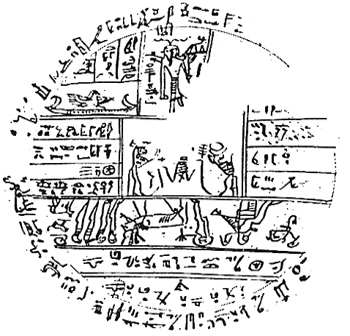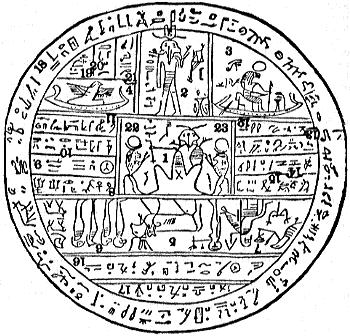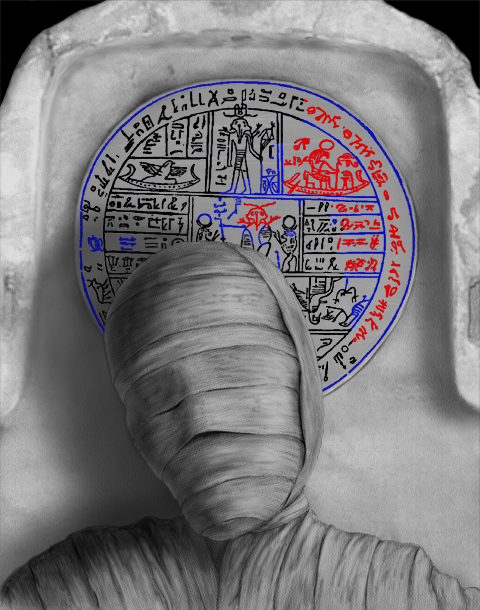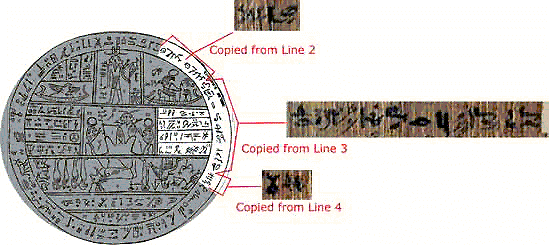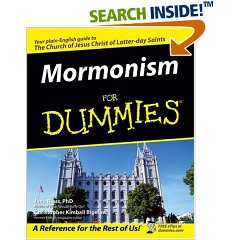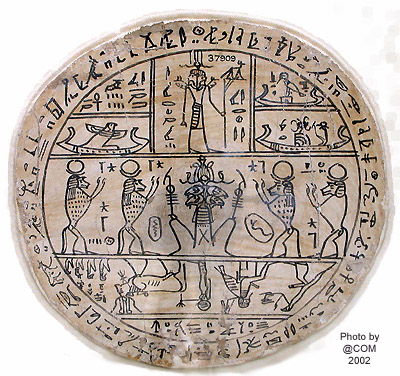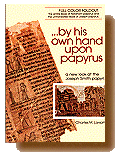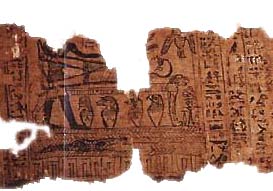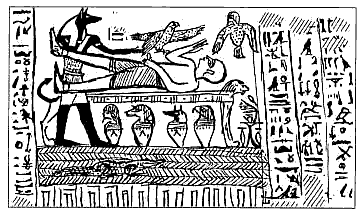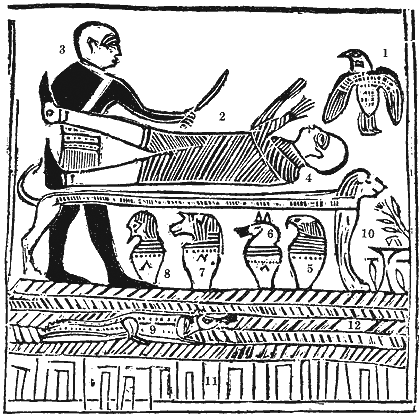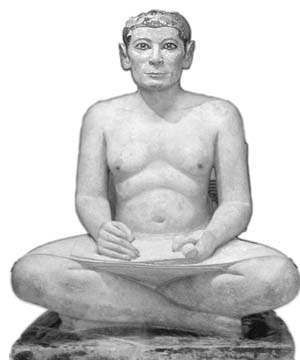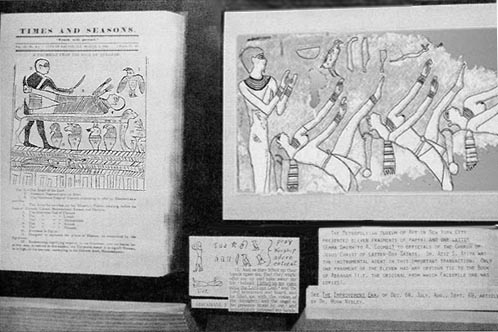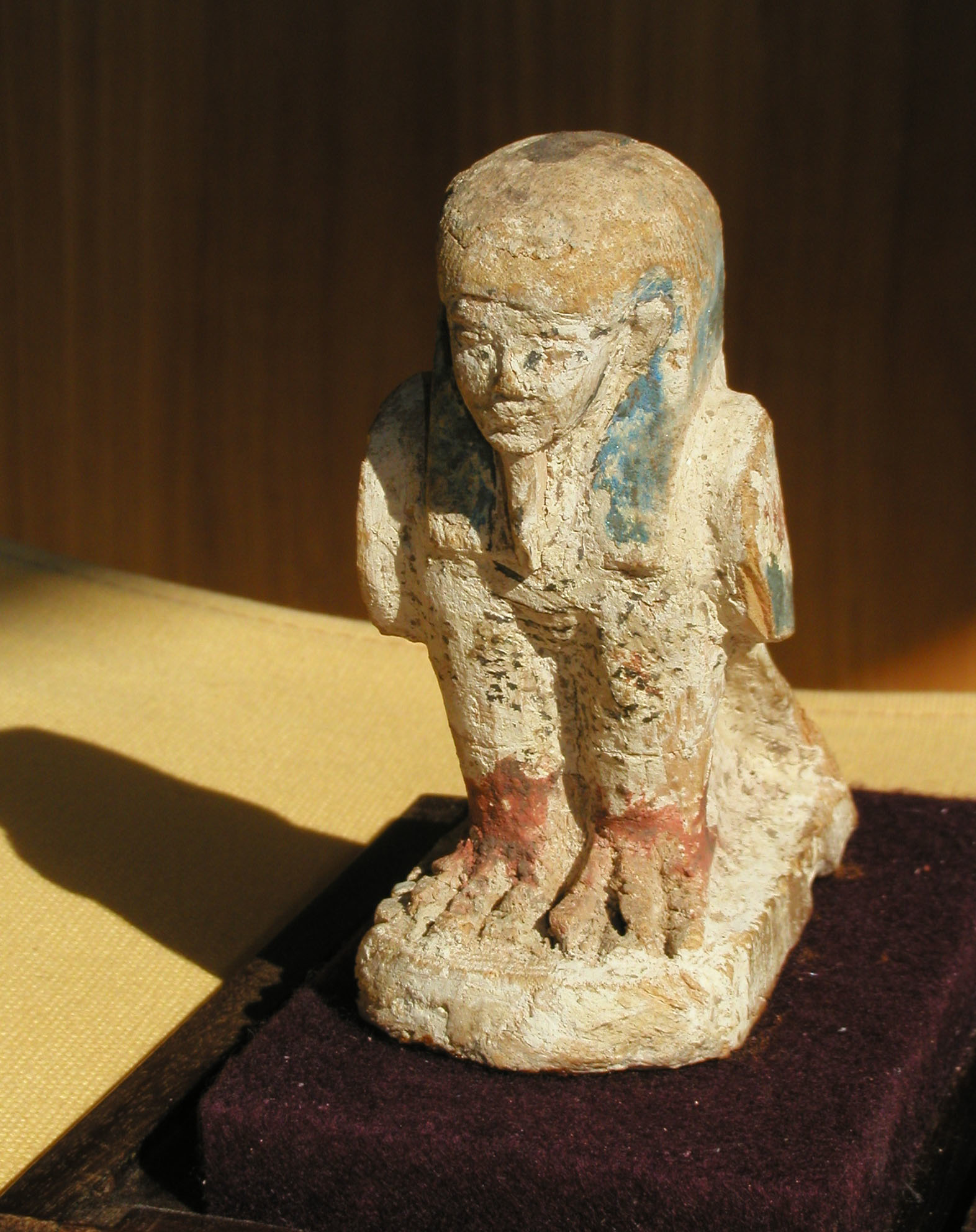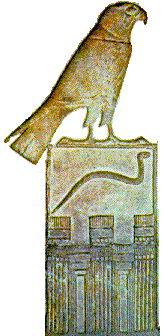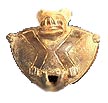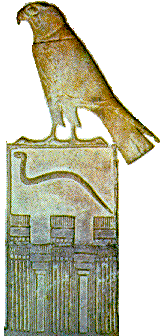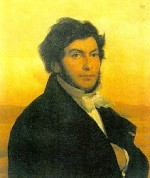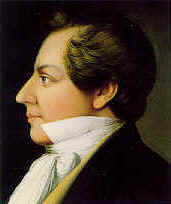|
|
||
|
Links: Facsimile 1 | Egyptian Alphabet | Facsimile B | Jos. Smith Papyri | Hypocephalus Gallery | Sheshonq’s Hypocephalus | Hitler |
||
 |
JOSEPH SMITH'S TRANSLATION OF FACSIMILE NO. 2 | |
| JOS. SMITH'S TRANSLATION | CORRECT TRANSLATION | |
|
|
Original
document
Facsimile
2 |
"Translated"
document
Facsimile 2
|
| Fig. 1 | Kolob *, signifying the first creation, nearest to the celestial, or the residence of God. First in government, the last pertaining to the measurement of time. The measurement according to celestial time, which celestial time signifies one day to a cubit. One day in Kolob is equal to a thousand years according to the measurement of this earth, which is called by the Egyptians Jah-oh-eh. | "The spirit of the four elements (according to Champollion), or rather of the four winds, or the four cardinal points; the soul of the terrestrial world. This god is always represented with four rams' heads, and his image has certainly been altered here. — They have also evidently made a very clumsy attempt at copying the double human head of the god figured above, fig. 2, instead of the four rams' heads. The word Jah-oh-eh has nothing Egyptian in it; it resembles the Hebrew word [redacted] badly transcribed." (emphasis in original) The name hieroglyph above the central figure is Chnm-Re, the Egyptian "First Creator" god who organized everything out of the primordial chaos. |
| Fig. 2 | Stands next to Kolob *, called by the Egyptians Oliblish, which is the next grand governing creation near to the celestial or the place where God resides; holding the key of power also, pertaining to other planets; as revealed from God to Abraham, as he offered sacrifice upon an altar, which he had built unto the Lord. | "Ammon-Ra, with two human heads, meant probably to represent both the invisible or mysterious principle of Ammon, and the visible or luminous principle of Ra, the sun; or else the double and simultaneous principle of father and son; which characterizes divinity in the religion of ancient Egypt. |
| Fig. 3 | Is made to represent God, sitting upon his throne, clothed with power and authority; with a crown of eternal light upon his head; representing also the grand Key-words of the Holy Priesthood, as revealed to Adam in the Garden of Eden, as also to Seth, Noah, Melchizedek, Abraham, and all to whom the Priesthood was revealed. | "The sun god Ra, with a hawk's head, seated in his boat. In the field the two symbolical figuring, according to M. de Rougé, the fixed points of an astronomical period." |
| Fig. 4 | Answers to the Hebrew word Raukeeyang, signifying expanse, or the firmament of the heavens; also a numerical figure, in Egyptian signifying one thousand; answering to the measuring of the time of Oliblish, which is equal with Kolob in its revolution and in its measuring of time. | Deveria commented; "The Hebrew word [redacted], Roki'a, expansum, solidum, ecclum, firmamentum, besides being badly described, has no relation whatever to this figure, which represents a mummified hawk, called in Egyptian Ah'em. It is the symbol of the divine repose of death; its extended wings have reference to the resurrection." |
| Fig. 5 | Is called in Egyptian Enish-go-on-dosh; this is one of the governing planets also, and is said by the Egyptians to be the Sun, and to borrow its light from Kolob through the medium of Kae-e-vanrash, which is the grand Key, or, in other words, the governing power, which governs fifteen other fixed planets or stars, as also Floeese or the Moon, the Earth and the Sun in their annual revolutions. This planet receives its power through the medium of Kli-flos-is-es, or Ha-ko-kau-beem, the stars represented by numbers 22 and 23, receiving light from the revolutions of Kolob *. | "The mystic cow, the great cow, symbolizing the inferior hemisphere of the heavens. It is called the virgin cow at ch. 162 of the funerary ritual, which particularly enjoins that its image be painted on the hypocephalus, and another image of it in gold on the throat of the defunct. It is the form of Hathor, who figures on several monuments under the name of noub, gold. Behind the cow is a goddess, whose head, represented by a mystic eye in a disk, is incorrectly copied." (emphasis in original) |
| Fig. 6 | Represents this earth in its four quarters. | "The four funerary genii, the sons of [Horus], Amset, Hapy, Tioumautew, and Kebhsoniw." |
| Fig. 7 | Represents God sitting upon his throne, revealing through the heavens the grand Key-words of the Priesthood; as, also, the sign of the Holy Ghost unto Abraham, in the form of a dove. | "The form of Ammon, with a bird's tail, or Horammon (?). An ithyphallic serpent, with human legs, offers him a symbolical eye. This last figure has certainly been altered in the hypocephalus of the Mormons." |
| Fig. 8 | "Contains writing that cannot be revealed unto the world; but is to be had in the Holy Temple of God, where | "Grant that the soul of the Osiris Sheshonk may live". |
| Fig. 9 | Ought not to be revealed at the present time | "The netherworld (below the earth) and his great waters". |
| Fig. 10 | Also | "O mighty god, lord of heaven and earth". |
| Fig. 11 | If the world can find out these numbers, so let it be. Amen. |
"O god of
the sleeping ones from the time of creation". (A single message, in this order: 11, 10, 9, 8.) |
| Figs. 12 - 15 |
...will be given in the own due time of the Lord. The above translation is given as far as we have any right to give at the present time"
|
A trace of the original hieroglyphic writing from this hypocephalus is visible on the left edge of Figs. 12, 13, 14 and 15 but only the phrase "his words" can be made out at the end of the line in Fig. 15. The remainder of these lines are filled with hieratic writing taken from another source (Papyrus Joseph Smith XI). |
| Fig. 12 (upside down) "near" and "wrap" | ||
| Fig. 13 (upside down) "which made by" | ||
| Fig. 14 (upside down) "breathings" | ||
| Fig. 15 (upside down) "this book" | ||
| Fig. 16 | "and may this soul and its possessor never be desecrated in the netherworld". | |
| Fig. 17 | "May this tomb never be desecrated" | |
| Fig. 18 |
Three-fourths of the original hieroglyphic inscription has survived. Counterclockwise it reads: "I am Djabty in the house of Benben in Heliopolis, so exalted and glorious. [I am] copulating bull without equal. [I am] that mighty god in the house of Benben in Heliopolis ... that mighty god..." |
|
| Figs. 19 - 21 | "You shall be as that god, the Busirian". | |
| Figs. 22 - 23 | "The name of this mighty god". | |
|
The Book of Abraham papyri were thought lost in the 1871 Great Chicago Fire. However, in 1966 several fragments of the papyri were found in the archives of the Metropolitan Museum of Art in New York, and in the LDS Church archives. They are now referred to as the Joseph Smith Papyri. Upon examination by professional LDS and non-LDS Egyptologists, the papyri were found to bear no resemblance to Joseph Smith's interpretation, and were common Egyptian funerary texts, dating to about the first century BC. As a result, the Book of Abraham has been the source of significant controversy, with Mormon apologists offering a variety of explanations as to the reason for the differences. The figure represented by Facsimile 2 is a common Egyptian artifact called a hypocephalus. Hypocephali are placed under the head or feet of the mummified person to assist them in remembering what to say and do in relation to the trials they would face after death. As with Facsimile No. 1, Smith's explanation differs from the standard interpretation. |
||
